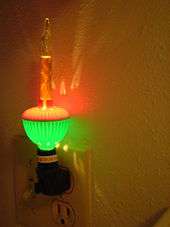Nightlight
| Look up nightlight in Wiktionary, the free dictionary. |

A nightlight is a small light fixture, often electrical, placed for comfort or convenience in dark areas or areas that may become dark at certain times, such as in an emergency. Small long-burning candles serving a similar function are referred to as tealights.
Use and culture
People often use nightlights for the sense of security which having a light on provides, and for a solution against nyctophobia (fear of the dark). Besides their usefulness to children in the allaying of their fears, nightlights are also useful to the general public by showing the general layout of a room without turning on a major light, for avoiding tripping over stairs or obstacles, or to mark an emergency exit. Exit signs often use tritium in the form of a traser. Some homeowners place nightlights in bathrooms to avoid turning on the main light fixture and causing their eyes to adjust to the light.[1]
Safety
The U.S. Consumer Product Safety Commission reports its receives about 10 reports per year where nightlights close to flammable materials were cited as responsible for fires; they recommend the use of nightlight with bulbs cooler than the four or seven watt bulbs used in some products.[2]
Potential health issues and benefits
A University of Pennsylvania study indicated that sleeping with the light on or with a nightlight was associated with a greater incidence of nearsightedness in children.[3] A later study at The Ohio State University, however, contradicted the earlier conclusion.[4] Both studies were published in the journal Nature.
Another study has indicated that sleeping with the light on may protect the eyes of diabetics from retinopathy, a condition that can lead to blindness.[5] However, the initial study is still inconclusive.
The optimal sleeping light condition is total darkness.[6] If using a nightlight, it is recommended to choose a dim light to minimize effects on sleep cycles.[1]Otherwise, nightlights should be used in areas other than sleeping areas such as hallways, bathrooms, or kitchens. This way, night trips can be made without turning on the full light, while preserving a dark sleeping environment.
See also
References
- 1 2 "National Sleep Foundation". National Sleep Foundation. Retrieved June 23, 2015.
- ↑ "Fire Hazard with Nightlights". CPSC Document #5063. U.S. Consumer Product Safety Commission. Retrieved May 12, 2011.
- ↑ "Is Nearsightedness in Children Linked to Night Light Exposure During Sleep Before Age Two?" (PDF). Science NetLinks. American Association for the Advancement of Science. Retrieved March 23, 2009.
- ↑ "Night Lights Don't Lead To Nearsightedness, Study Suggests". Science Daily. March 9, 2000. Retrieved March 23, 2009.
- ↑ "Light at Night Protects Diabetics' Eyes". WebMD. June 27, 2002. Retrieved March 23, 2009.
- ↑ Rettner, Rachel. "Avoiding Depression: Sleeping in Dark Room May Help". Live Science. Retrieved 23 June 2015.
External links
| ||||||||||||||||||||||||||||||||||||||||||||||||||||||||